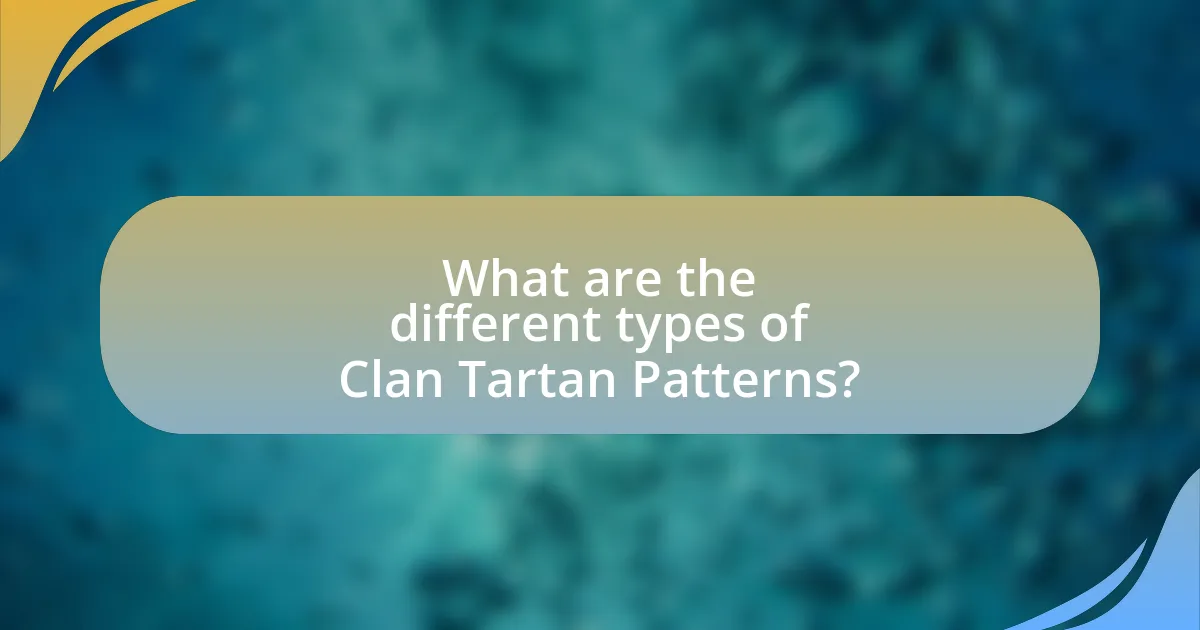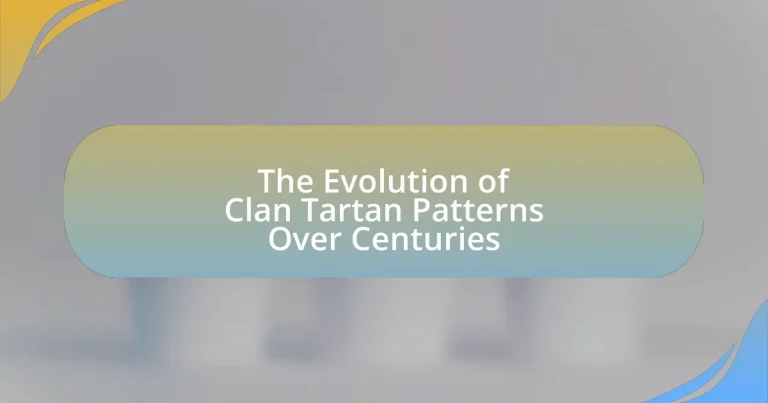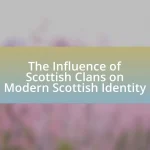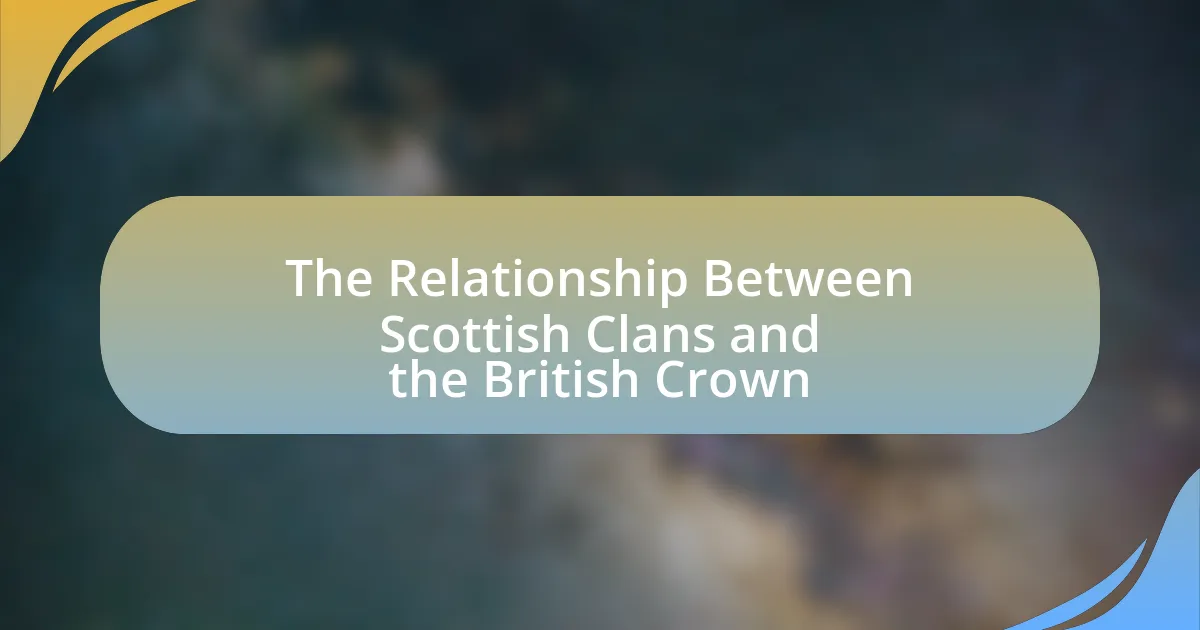Clan tartan patterns are unique textile designs that represent specific Scottish clans, characterized by distinct color combinations and geometric patterns. Originating in the 16th century, these patterns served as identifiers for clans and became symbols of Scottish heritage, particularly during the 18th and 19th centuries. The article explores the historical significance, cultural influences, and evolution of clan tartan patterns, detailing their role in representing family lineage and identity, the impact of natural dyes, and the effects of major historical events. Additionally, it examines how contemporary fashion trends have adapted these traditional designs, ensuring their relevance in modern Scottish culture.

What are Clan Tartan Patterns and Their Historical Significance?
Clan tartan patterns are distinctive textile designs associated with specific Scottish clans, characterized by their unique color combinations and geometric patterns. Historically, these patterns served as a means of identification for clans, particularly during the 18th and 19th centuries when they became symbols of Scottish heritage and pride. The use of tartan was codified in the 19th century, with the establishment of the Scottish Tartan Authority, which documented various clan patterns, solidifying their significance in Scottish culture. Tartan patterns not only represent familial ties but also reflect regional identities, as different areas of Scotland developed their own unique styles, further emphasizing the cultural importance of these patterns in Scottish history.
How did Clan Tartan Patterns originate?
Clan tartan patterns originated in Scotland as a means of identifying different clans and families. The use of distinctive patterns dates back to the 16th century, with the earliest documented tartans appearing in the 1630s. These patterns were woven into woolen cloth, often using natural dyes, and served both practical and symbolic purposes, representing clan identity and heritage. Historical records, such as the “Book of Tartan” published in the 19th century, further solidified the association of specific patterns with particular clans, contributing to the rich tradition of tartan in Scottish culture.
What cultural influences shaped the early designs of Clan Tartan Patterns?
The early designs of Clan Tartan Patterns were shaped primarily by Scottish heritage, local geography, and social status. Scottish clans used tartan patterns to signify their identity, with specific colors and designs representing different clans. The natural dyes available from local flora influenced the color palette, while the patterns often reflected the landscape, such as the use of greens and browns to mimic the Scottish Highlands. Additionally, the social hierarchy played a role, as certain patterns were reserved for nobility, indicating rank and lineage. Historical records, such as the 16th-century “Book of Tartan,” document these associations, confirming the cultural significance of tartan in Scottish society.
How did the use of natural dyes impact the development of these patterns?
The use of natural dyes significantly influenced the development of clan tartan patterns by providing a diverse palette of colors that were derived from local flora and fauna. These dyes allowed artisans to create intricate designs that reflected regional identities and cultural significance. For instance, the availability of specific plants, such as madder for red and woad for blue, directly impacted the color combinations and patterns that emerged in different clans. Historical records indicate that the distinct hues achieved through natural dyes were not only aesthetically pleasing but also served as identifiers of clan lineage and status, thereby reinforcing social cohesion within communities.
Why are Clan Tartan Patterns important to Scottish identity?
Clan tartan patterns are important to Scottish identity because they serve as symbols of heritage, belonging, and cultural pride. Each tartan is uniquely associated with a specific clan, representing its history, values, and lineage. Historically, tartans were used to identify clans during conflicts and gatherings, fostering a sense of unity among members. The Scottish government officially recognized tartans in the 19th century, further solidifying their role in national identity. Today, tartans are celebrated in events like the Highland Games and are integral to Scottish ceremonies, reinforcing their significance in contemporary Scottish culture.
How do Clan Tartan Patterns represent family lineage and heritage?
Clan tartan patterns represent family lineage and heritage by serving as unique identifiers for specific clans in Scotland. Each tartan design is associated with a particular clan, reflecting its history, values, and social status. For example, the MacLeod tartan features distinct colors and patterns that signify the clan’s identity and lineage, allowing members to visually connect with their ancestry. Historically, these patterns were used to distinguish clans during battles and gatherings, reinforcing a sense of belonging and pride among clan members. The use of tartans has been documented since the 16th century, with specific patterns being officially registered to clans, further solidifying their role in representing family heritage.
What role do Clan Tartan Patterns play in modern Scottish culture?
Clan tartan patterns serve as a significant symbol of identity and heritage in modern Scottish culture. These patterns are often associated with specific clans, representing familial ties and regional pride. The resurgence of interest in Scottish heritage, particularly during events like the Highland Games and cultural festivals, has led to an increased visibility of tartan in contemporary fashion and home decor. Additionally, the Scottish Parliament recognized the importance of tartan by establishing Tartan Day, celebrated on April 6th, which further emphasizes its role in promoting Scottish culture globally. The use of tartan in modern clothing, accessories, and even corporate branding illustrates its enduring relevance and connection to Scottish identity.

How have Clan Tartan Patterns evolved over the centuries?
Clan tartan patterns have evolved significantly over the centuries, transitioning from simple, locally produced designs to complex, standardized patterns recognized globally. Initially, tartans were handwoven by families using natural dyes and materials, resulting in unique patterns that represented specific clans or regions. By the 18th century, the introduction of commercial dyeing processes and the Industrial Revolution led to the mass production of tartans, allowing for a wider variety of colors and patterns. The establishment of the Scottish Tartan Authority in the 19th century further standardized tartan patterns, creating a system for identifying and registering clan designs. This evolution reflects broader cultural shifts, including the romanticization of Scottish heritage during the Victorian era, which popularized tartan as a symbol of national identity.
What major historical events influenced changes in Clan Tartan Patterns?
Major historical events that influenced changes in Clan Tartan Patterns include the Jacobite uprisings, the Highland Clearances, and the Acts of Proscription. The Jacobite uprisings in the 17th and 18th centuries led to a resurgence in the use of tartan as a symbol of Scottish identity and rebellion against British rule. Following the defeat of the Jacobites in 1746, the British government enacted the Dress Act of 1746, which banned the wearing of tartan in an attempt to suppress Highland culture. This act was repealed in 1782, allowing for the revival and diversification of tartan patterns. The Highland Clearances in the 18th and 19th centuries, which involved the forced eviction of tenants, also contributed to changes in tartan as displaced clans sought to maintain their identity through distinct patterns. These events collectively shaped the evolution of tartan patterns, reflecting both cultural pride and the impact of political turmoil.
How did the Jacobite uprisings affect the popularity of certain tartans?
The Jacobite uprisings significantly increased the popularity of certain tartans, particularly those associated with the Jacobite cause and Scottish clans that supported it. Following the uprisings, tartans became symbols of Scottish identity and resistance, leading to a resurgence in their use among both supporters and the general public. The 1745 uprising, in particular, saw the promotion of specific patterns like the Stuart tartan, which became emblematic of the Jacobite movement. This association with national pride and rebellion solidified the tartans’ status, influencing their adoption in various social contexts and contributing to the broader cultural revival of Scottish heritage in the 19th century.
What impact did the Industrial Revolution have on tartan production?
The Industrial Revolution significantly increased tartan production by introducing mechanized weaving techniques and dyeing processes. This transformation allowed for mass production of tartan fabrics, making them more accessible and affordable to a broader audience. Prior to the Industrial Revolution, tartans were handwoven and produced in limited quantities, often tailored for specific clans. The advent of power looms and synthetic dyes in the 18th and 19th centuries enabled manufacturers to create a wider variety of patterns and colors, leading to a diversification of tartan designs. Consequently, the increased availability of tartan contributed to its popularity beyond traditional Scottish clans, influencing fashion and culture in various regions.
How have fashion trends affected the evolution of Clan Tartan Patterns?
Fashion trends have significantly influenced the evolution of Clan Tartan Patterns by introducing new colors, designs, and applications that reflect contemporary aesthetics. For instance, during the Victorian era, tartans became popularized in mainstream fashion, leading to the creation of lighter, more vibrant patterns that appealed to a broader audience. The 20th century saw further evolution as designers like Vivienne Westwood incorporated tartan into punk fashion, transforming traditional patterns into symbols of rebellion. This adaptability of tartan patterns to fit modern styles demonstrates their ongoing relevance and evolution in response to changing fashion trends.
What are some notable modern adaptations of traditional tartan designs?
Notable modern adaptations of traditional tartan designs include the use of tartan in contemporary fashion collections by designers such as Vivienne Westwood and Alexander McQueen, who have incorporated bold colors and innovative cuts. Additionally, brands like Burberry have reinterpreted classic tartan patterns in their luxury products, blending heritage with modern aesthetics. The rise of digital printing technology has also allowed for unique variations, enabling designers to create custom tartans that reflect personal or cultural narratives, thus expanding the traditional use of tartan beyond its historical roots.
How do contemporary designers incorporate Clan Tartan Patterns into their work?
Contemporary designers incorporate Clan Tartan Patterns into their work by integrating traditional motifs into modern fashion and interior design. This integration often involves reinterpreting classic tartan designs with innovative color palettes and materials, making them relevant for today’s aesthetic preferences. For instance, designers like Vivienne Westwood and Alexander McQueen have famously utilized tartan in their collections, blending historical significance with contemporary silhouettes. Additionally, brands such as Burberry have modernized tartan patterns in their iconic trench coats, showcasing how these patterns can be adapted for luxury markets while maintaining their cultural heritage. This approach not only preserves the historical context of Clan Tartans but also revitalizes them for new audiences, ensuring their continued relevance in contemporary design.

What are the different types of Clan Tartan Patterns?
Clan tartan patterns can be categorized into several types, including ancient, modern, and weathered tartans. Ancient tartans are characterized by their muted colors and were typically made from natural dyes, reflecting the historical practices of weaving. Modern tartans, developed in the 19th century, feature brighter colors and more complex patterns, often created for specific clans or organizations. Weathered tartans simulate the appearance of faded colors, giving a vintage look that suggests age and wear. Each type serves to represent the heritage and identity of Scottish clans, with specific patterns often linked to particular families or regions.
How are Clan Tartan Patterns categorized?
Clan tartan patterns are categorized primarily by their specific clan associations, color schemes, and design elements. Each tartan is linked to a particular Scottish clan, with distinct patterns that often reflect the clan’s history and heritage. Additionally, tartans can be classified into categories such as ancient, modern, and weathered, which denote variations in color intensity and dyeing techniques used over time. Historical records and tartan registries, such as the Scottish Register of Tartans, provide evidence of these classifications, ensuring that each pattern is accurately attributed to its respective clan and context.
What distinguishes ancient tartans from modern tartans?
Ancient tartans are distinguished from modern tartans primarily by their weaving techniques and color palettes. Historically, ancient tartans were handwoven using locally sourced natural dyes, resulting in a more muted and earthy color scheme, while modern tartans often utilize synthetic dyes and advanced weaving technology, allowing for brighter and more varied colors. Additionally, ancient tartans typically featured simpler patterns and fewer colors, reflecting the limited resources and techniques of the time, whereas modern tartans can incorporate complex designs and a wider range of hues, reflecting contemporary fashion trends and technological advancements in textile production.
What are the characteristics of district tartans versus clan tartans?
District tartans are designed to represent specific geographical areas, while clan tartans symbolize individual Scottish clans. District tartans typically feature patterns that reflect the local landscape or heritage, often incorporating colors and designs that resonate with the region’s identity. In contrast, clan tartans are unique to each clan, with specific patterns and colors that signify lineage and family ties, often passed down through generations. The distinction is further emphasized by the fact that clan tartans are often registered with the Scottish Tartans Authority, ensuring their authenticity and connection to a particular clan’s history.
What are some famous Clan Tartan Patterns and their stories?
Famous Clan Tartan Patterns include the MacGregor, Campbell, and MacLeod patterns, each with unique stories. The MacGregor tartan, associated with the MacGregor clan, symbolizes resilience, as the clan faced persecution in the 17th century, leading to the banning of their name. The Campbell tartan, linked to the powerful Campbell clan, reflects their historical influence in Scottish politics and land ownership, with variations representing different branches of the clan. The MacLeod tartan, recognized for its vibrant colors, tells the story of the MacLeod clan’s seafaring heritage and their strong ties to the Isle of Skye. Each tartan not only represents a family lineage but also encapsulates significant historical narratives and cultural identity within Scotland.
How did the Black Watch tartan become iconic?
The Black Watch tartan became iconic due to its association with the Black Watch regiment, which was formed in 1725 and played a significant role in British military history. The tartan’s distinctive dark green and navy blue pattern symbolized loyalty and bravery, contributing to its recognition and popularity. Its adoption by the regiment during various conflicts, including the Napoleonic Wars and World War I, solidified its status as a symbol of Scottish heritage and military tradition. The tartan’s widespread use in fashion and culture further enhanced its iconic status, making it a recognizable emblem of Scotland globally.
What is the significance of the Royal Stewart tartan in Scottish history?
The Royal Stewart tartan is significant in Scottish history as it is the personal tartan of the British royal family and symbolizes loyalty and heritage. This tartan, characterized by its red and green check pattern, has been associated with the House of Stewart since the 15th century, reflecting the clan’s prominence in Scottish history. The Royal Stewart tartan gained further recognition when it was adopted by Queen Victoria and Prince Albert in the 19th century, solidifying its status as a symbol of Scottish identity and royal lineage.
What are best practices for choosing and wearing Clan Tartan Patterns?
Best practices for choosing and wearing Clan Tartan Patterns include selecting a tartan that represents your specific clan or family heritage, ensuring the pattern aligns with the occasion, and considering the fabric and garment style for comfort and appropriateness. Choosing a tartan linked to your ancestry fosters a connection to cultural identity, as many clans have distinct patterns recognized since the 18th century. Additionally, wearing tartan in formal settings, such as weddings or clan gatherings, is traditional, while casual wear may allow for more flexibility in pattern choice. The fabric should be suitable for the climate and the garment type, as wool is commonly used for kilts and jackets, providing warmth and durability.
How can individuals select the right tartan for their family or personal style?
Individuals can select the right tartan for their family or personal style by considering their heritage, personal preferences, and the specific meanings associated with different tartans. Heritage plays a crucial role, as many tartans are linked to specific clans or regions in Scotland, and choosing a tartan that reflects one’s ancestry can foster a sense of identity. Personal preferences, such as color schemes and patterns, should also be taken into account, as individuals may prefer certain aesthetics that resonate with their style. Additionally, understanding the symbolism behind tartans, such as those representing loyalty or bravery, can guide individuals in making a choice that aligns with their values. Historical records indicate that tartans have evolved over centuries, with distinct patterns emerging for various clans, which can further inform the selection process.
What tips should one follow when incorporating tartan into modern attire?
To effectively incorporate tartan into modern attire, one should focus on balancing traditional patterns with contemporary styles. This can be achieved by selecting tartan pieces that complement modern silhouettes, such as pairing a tartan blazer with fitted jeans or a tartan scarf with a minimalist outfit. Additionally, mixing tartan with solid colors or neutral tones can prevent overwhelming the look, allowing the tartan to serve as a statement piece. Historical context supports this approach, as tartan has evolved from traditional Scottish wear to a versatile fabric embraced in various fashion trends, demonstrating its adaptability in modern wardrobes.





